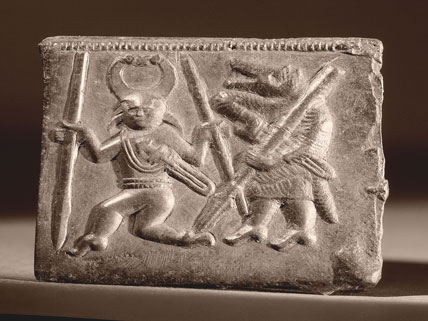
The helmeted figure dancing with a warrior in a wolf mask on this sixth-century bronze Viking plate may echo the tradition of Proto-Indo-European boys running in “wolf packs.”
Archaeological sites can be like giant jigsaw puzzles—except there’s no picture on the box lid, and there’s no telling how many pieces are missing. However, language and mythology studies can fill in some gaps. A 4,000-year-old site named Krasnosamarskoe on the steppes of western Russia provides an example.
Archaeologists were stumped by what they found at Krasnosamarskoe—chopped-up bones of 64 wolves and dogs that clearly had not been killed for food. The bones seemed to indicate animal sacrifice, but for what purpose? A search for information on dog sacrifices yielded an intriguing story. The people who lived at the Russian site probably spoke a language now called Proto-Indo-European (PIE), which eventually evolved into most of the European languages, including English, and several Asian tongues. Among the speakers of PIE and its later forms was a tradition of young men who didn’t fit in well in their communities forming warrior bands that would raid other settlements for livestock or other goods. In some areas of Europe, these bands thought of themselves as wolf packs. In the Rigveda, an ancient text written in the Indo-European language Sanskrit, a young man who wants to become a warrior has to sacrifice a dog and wear its skin for four years. So the practice of boy bands and dog sacrifice seems to have been widespread among PIE-speaking peoples. Linguists were even able to conclude that the PIE word for these gangs was koryos.
Another puzzle piece was supplied by an examination of the butchered dogs’ and wolves’ teeth. Growth bands on the teeth indicated that most of the animals had been sacrificed in the winter. A picture develops of rowdy boys being initiated into “wolf pack” bands during wintertime rituals that involved animal sacrifices. A theory proposes that we even know how many boys were in each band—eight. The number eight, in association with raiding and warriors, occurs often in ancient texts from places as far-distant as India and Sweden.
Image credit: © Photo by Werner Forman/Universal Images Group/Getty Images
Related Links
- Wolf Rites of Winter
Read how historians, archaeologists, linguists, and an archaeozoologist worked together to solve the mystery of Krasnosamarskoe.
(Source: Archaeology Magazine, September/October, 2013) - Boys Killed Pets to Become Warriors in Early Russia
Learn what boys had to give up so they could become warriors, according to the authors.
(Source: National Geographic, May 14, 2013) - Indo-European Branches of the Language Tree
How is English related to Hindi? Romanian to French? Persian to Pashto? Find out here.
(Source: Iowa State University; accessed August 31, 2013)




what does this have to do with boybands
i hate pie mud pie ihate it
Me to
This stuff is cool
This stuff is wierd